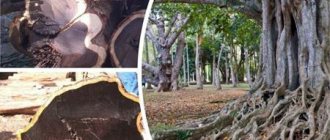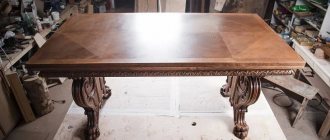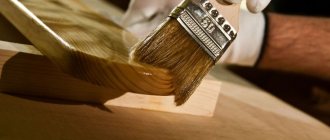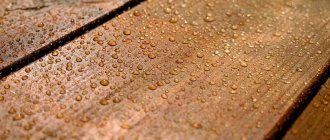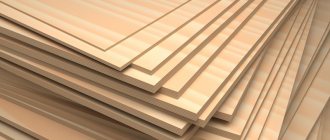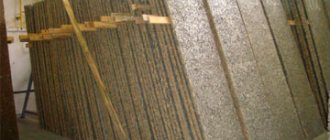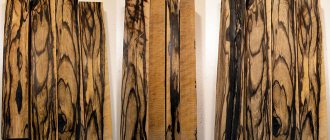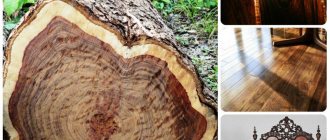Titles: zebrano, zingana.
Botanical family: caesalpiniaceae.
Latin name: microberlinia brazzavillensis, microberlinia bisulcata, brachystegia fleuryana.
Other names: zebra wood (Great Britain), zingana (Gabon and Cameroon).
Spreading. Gabon and Cameroon.
Wood. Decorative light golden color, with narrow strokes ranging from dark brown to almost black. The surface is shiny. The texture is somewhat coarse. The wood is hard and heavy.
Technological properties. It is used primarily in the form of veneer, usually for decorative veneering of edges. The veneer is planed radially to avoid warping (bulging) due to alternating hard and soft zones. The veneer must be glued carefully and treated with a transparent, light-colored filler before polishing. When processed on belt sanding machines, a high-quality surface is obtained.
Description
Zebrawood, whose other names are zingana, African zebra tree, is found in western Africa: Cameroon, Congo, Gabon. It often grows singly, the trunks rise in length to almost 40 m, having a cross-sectional diameter of about 1 m. The tree begins to branch in the upper part, at least 20 meters in height, forming a wide, dense dark green crown. It is impossible to find massive forest stands of this species even in its homeland.
Officially, cutting down zebrawood is prohibited; for this reason, lumber from it is not available for free sale. Due to its exotic appearance and high decorative qualities, the wood is one of the rare elite varieties.
Zebrawood in furniture
In furniture, zebrawood is usually used in the form of facades or inserts. Only very wealthy people can afford furniture made entirely of zebrawood, since this is a valuable and, accordingly, very expensive tree species.
Furniture with zingana inserts defines the entire style of the room. The color of the floor, ceiling and walls, as well as decoration and accessories are selected to match it.
Characteristics of wood
The texture of the material includes alternating dark and light stripes. At the same time, sapwood has a pale color and low technical characteristics, and is not popular. Only heartwood is valued, which, depending on the region of growth, has various shades: sand, light yellow, ivory, cream, light brown, golden, caramel, gray, red and almost black. The background can be either dark or light, combined with contrasting lines of varying density and width running along the fibers. Light brown massif with dark stripes is more common. The structure of the material is small-vascular, quite coarse, and often has curling patterns - interlacing and waviness of the fibers. In addition to the lines on the canvas, there are also contrasting spots of various sizes and shapes. The layers of wood are unevenly dense.
Drying of the raw material is carried out in several stages and very slowly, at a temperature not exceeding 48°C and strictly controlled ambient humidity. Before drying, it is recommended to make a radial cut of the logs to prevent deformation. Zebrawood is capricious and can crack or warp if you make the slightest mistake in applying the technology. The total shrinkage during the drying process is about 11%.
Dry wood is very heavy and durable, resistant to impact loads, compression and bending. Its density is more than 750 kg/m³, Brinell hardness is 4.1 units. Thanks to these qualities, zebrawood is practically resistant to pests - fungi and insects - and has excellent biostability.
Selecting a shade
There are more varieties of zebrawood than one would expect from a single African tree, so you will have to choose the right one carefully. Regardless of what shade you want to use in your kitchen, keep two things in mind:
- Each color should have its place: sand zebrawood, for example, is practically never used for making countertops, and dark zebrawood is rarely used for laying floors.
- Be careful in choosing colors - any shade of zebrawood goes well with a good dozen colors, but among them there are practically no “pure” ones: if it’s red, then it’s most likely scarlet, if it’s blue, then it’s cobalt, and so on.
Light zebrano
It has sapwood of a warm golden or rich beige color with contrasting dark stripes of different widths that form a beautiful longitudinal pattern.
This zebrawood is the most exotic, reminiscent of a sultry African afternoon, so it is better to dilute it with pastel colors or, if you have a creative, energetic nature, shades of ocher and blooming poppies.
It looks very nice as a floor covering, but you should not overdo it with the parquet pattern: narrow strips, often alternating, disrupt the natural pattern of the material.
Sand zebrano
The most neutral color, which is suitable for those who do not like sharp transitions and contrasts. On a sandy, light beige background, stripes of a slightly darker shade are intertwined.
Sand kitchen looks cute and fresh, especially in combination with light shades. It is best to make the facade of the kitchen and the work surface from sand zebrawood; it also looks good on the floor, since the stripes smoothly flow into one another, creating an even, calm tone.
Gray Zebrawood
A cool, noble color that looks very elegant in high-tech and modern interiors. The sapwood is light beige or gray, the strips themselves are also gray.
This “color” looks good both on the floor and in the façade of the kitchen itself, giving it subtle beauty and cleanliness, but not the sterility that is characteristic, for example, of white tiles.
It goes well with most cool shades, but is simply perfect with white and black, which makes gray zebrawood popular among lovers of minimalism in everything.
Dark zebrawood kitchen
The tone consists of alternating stripes of medium and very dark tones, the color range can range from amber-golden to rich coffee.
Such a kitchen, even in combination with the most neutral colors, looks very bright and festive, which is why dark zebrawood is very popular today.
It can be combined with light shades of wood, but should not be combined with gray zebrawood. It goes well with almost the entire color scheme, from black and white to red, blue and green.
Processing and scope of application
Like any dense wood, zebrawood is difficult to saw and other types of mechanical and manual processing. For this purpose, it is recommended to use tools with alloy steel blades and tungsten elements. Zebrawood's moisture resistance is average. In conditions with high air humidity, it can be used without the risk of destruction, but with constant contact with water it gradually swells. For this reason, the material requires appropriate types of processing to protect it from exposure to adverse environments. Wood lends itself well to sanding, polishing, waxing, and coating with varnishing and tinting compounds.
Zebrawood is not widely used in construction due to its rarity and high cost. Areas of its use:
- creation of exclusive interiors: production of finishing panels for the walls of premises, interior decoration of expensive cars, furniture, design objects, piece parquet, inlays;
- collectible musical instruments: guitar bodies;
- knife handles, door handles, pistol grips, chess pieces;
- sports items: skis, billiard cues.
Solid zebrawood is used very rarely; the unique natural grain of the wood is clearly demonstrated when veneer and plywood are made from it. At the same time, taking into account the high density of the material, not the common peeling method is used, but planing. Finishing from this wood allows you to refine any interior, making it truly unique. Zebrawood is almost never used in exterior finishing; its main purpose is interior design: office space, living rooms, bedrooms, kitchen units, bathrooms.
The design even developed several rules for decorating a house using zebrawood finishing materials:
- It is recommended to combine this wood in the same interior with materials that are different in background color or texture: dark zebrawood, for example, goes well with panels made of light oak or birch, bright yellow, red, light green or lilac plain surfaces made of plastic, transparent, frosted glass or tiles , metal;
- Do not overload the space with “zebra” decoration: a few pieces of furniture or just one floor covering made of exotic wood is enough. The main requirement when using this wood is the laconicism and simplicity of the surrounding objects; a room completely covered with striped wood will look ridiculous;
- Zebrawood is not friendly with colorful finishing materials such as crocodile skin, leopard and tiger prints, rosettes, floral wallpaper, stucco molding, lambrequins, heavy gathered curtains, carved panels. The best styles for this material are aesthetic minimalism or hi-tech.
The price of zebrawood wood is high and not affordable for everyone: the cost of 1 sq. m of veneer starts from 6,000 rubles, 1 cubic. m of massif - 360–500 thousand rubles. At the same time, given the rarity and exotic nature of the breed, when purchasing material it is easy to run into a fake.
Physical and mechanical properties
In zebrawood wood, only its core is valued; it shows only good technical indicators. In addition, the quality of wood is affected by the age of the tree and its growing conditions. Mature trees are most highly valued. It is a durable wood and also resistant to moisture and most insects. The density of wood is within 0.79 g/cm3, and its hardness according to the Monin scale is 5.0.
To obtain good quality lumber, use the radial sawing method. It is quite easy to saw and process the surface of wood, but peeling due to the high degree of adhesion of wood grains is difficult. Zebrawood veneer glues well, which gives the product a stable and durable result.
How to combine zebrawood with other colors in the kitchen
White color. Looks good with sandy zebrawood, ideal with dark, almost black. It is not recommended to paint the entire kitchen in white; a work surface, countertop, ceiling and individual elements will suffice.
Beige color. Almost universal beige goes well with any shade of zebrawood, but you should avoid tandems in which the color of the wood itself is also beige: a slight contrast should still be present. Zebrano + beige = a win-win option for those who want to see the kitchen as an oasis of comfort and peace, where nothing hurts the eyes or makes you nervous.
Green color. Pairs perfectly with zebrawood, but with a caveat. It is better to choose emerald green for dark wood, grassy green for sandy wood, dark green for light wood, and gray zebrawood goes best with a marsh or jade shade. Such “woody-herbaceous” cuisines create an atmosphere of wild nature, while calming and toning.
Grey colour. Rarely used in such an exotic setting as a zebrawood interior. Looks best in interiors with gray zebrawood, but in limited quantities. Good in detail, but in large areas it is better to avoid a pure gray tint.
Orange color. Pure, “undiluted” orange is good next to golden and chocolate dark zebrawood, but if you have a kitchen made of light wood, it is better to use a darker shade close to scarlet. This combination is suitable for active people who are depressed by boring pastel colors.
Black color. A classic to be careful with. Black looks elegant and stylish with most varieties of zebrawood, but it is important not to overdo it.
The “bottom” facade or table, work surface, individual elements can be black - otherwise the kitchen will look like a dense cannibal’s lair.
Imagine, plan, think, and everything will work out. Good luck!
Zebrawood colors - their types
If the coloring of a real zebra is only black and white, then the zebrawood material boasts a wide range of colors.
Thin stripes located parallel to each other can be coffee-colored, dark chocolate-colored, or almost black. They are located on different backgrounds - pale gold, cream, beige, brown, etc.
There are many shades, and their main feature is a complete imitation of natural wood.
This means that a kitchen made of such material will look great in any interior, and choosing the appropriate accessories for it will not be difficult.
Zebrawood coloring always looks original and unusual, the stripes in it are arranged in a unique pattern - this style will appeal to extraordinary and creative individuals, and is unlikely to appeal to conservatives.
Zebrawood color can be present not only on the facades of the kitchen; it will also look appropriate in the decoration of the floor, walls and individual areas of the room.
Modern manufacturers also produce ceramic tiles of similar colors, laminate, porcelain tiles and many other finishing materials. They can be combined and create original combinations of shades that highlight and complement each other.
Headset design options
Many people's eyes dazzle from a kitchen entirely made in contrasting zebrawood. In this case, you can purchase (or order) a set with combined facades. With partial use of zebrawood finishing, the result is an equally stylish and often more impressive set, which is easier to fit into the interior.
Mix with black Source ohmscape
The characteristic zebra style can be present only in the lower (or upper) cabinets; the addition will be a shade that matches the color. For a successful result, the following rules apply:
- The “light top, dark bottom” technique works well, allowing you to visually enlarge the space.
- An African-style pencil case will help divide the kitchen into zones.
Rare combination of two zebrawood colors Source lh3.googleusercontent
- Whether the set will be glossy or matte depends on the preferences of the owners and the tasks set. Matte facades are a beautiful, but less practical option for a zebrano kitchen; gloss on a light surface reflects light well, which is beneficial in a small room.
Glossy facade Source houseadvice
- The option with upper facades made of frosted glass has a beautiful appearance. Metal profiles and fittings are appropriate in any case.
- Neutral color schemes sometimes seem boring. In this case, a kitchen apron will help correct the situation. Bright shades are suitable for decoration: light green, lavender, pink, pistachio. If you are a supporter of more practical shades, the bright accent can be transferred, for example, to the dining group.
Emphasis on red poppies Source indecor

